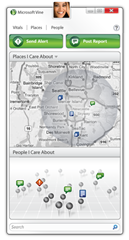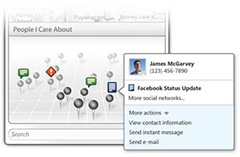 Microsoft have been working on what at first glance, might look like a Live Messenger like utility. What differs with Vine is that it is focused on staying in contact with those that are close to you in times of need, such as natural disasters, maybe riots or any situation where you might want to make arrange a quick plan for safety or survival. With the communication features that are built in, it could be used beyond this into everyday group organisation.
Microsoft have been working on what at first glance, might look like a Live Messenger like utility. What differs with Vine is that it is focused on staying in contact with those that are close to you in times of need, such as natural disasters, maybe riots or any situation where you might want to make arrange a quick plan for safety or survival. With the communication features that are built in, it could be used beyond this into everyday group organisation.
Consisting of a single window with three main panes/tabs: Vitals; Places; and People, the dashboard can receive emergency or news updates and these are displayed on a map in the Vitals pane in the form of push pins. Below the map is also a number of pushpins representing your contacts who may have alerts of their own which you can see. Hovering on the push pins on the map, as with online mapping services, provides a small popup with more information about the event/situation. Clicking on the popup will open up the source in a browser window. You can view any area of the map where you have specified a contact or location important to you. The application can pull in headlines from over 20,000 media sources as well as safety information from the US’s National Oceanic and Atmospheric Administration (NOAA). Hopefully this will provide a heads up of impending events before one gets in contact with another news source or the event itself.
 The Places window allows you to set up locations that you would like to have available to you on the main Vitals map. In the People window, individuals and groups of people can be added. These could be friends and family, your local football team, maybe even the local bar who could use it to advertise their offers at short notice! With the ability to add people into groups, one can message an entire group without having to add each contact one by one, instead using a short code/name that can be assigned to a group.
The Places window allows you to set up locations that you would like to have available to you on the main Vitals map. In the People window, individuals and groups of people can be added. These could be friends and family, your local football team, maybe even the local bar who could use it to advertise their offers at short notice! With the ability to add people into groups, one can message an entire group without having to add each contact one by one, instead using a short code/name that can be assigned to a group.
When creating an alert, the dashboard pane changes layout akin to that of an email with ‘Subject’, ‘Message’ and ‘Send To’ fields.
The Post Report button allows contacts to respond to alerts or send out their own unsolicited report on their own situation such as ‘Okay’ and ‘Not Okay’ with further detail if required as well such as being able to select one of four types of report: Check in safe and well; Report upcoming plans; Report a situation; and General information, allowing recipients to evaluate the importance of the report.
When receiving an alert, much like other instant messengers, a small window pops up with the message/alert and a box enabling you to reply. These reports can be received via mobile and email also, with mobile alerts being chargeable.
Microsoft intends to make this service available through other mediums such as Facebook and Twitter etc. No doubt one will be able to send out as well as receive alerts via their preferred social networking site.
 The few advantages this application has over a dedicated instant messenger, such as Windows Live Messenger and existing contact methods is the availability of a map and incoming reports on selected areas. The map and reports can provide alerts ahead of time, providing someone is watching the application at the time of an alert and the updates provide a notification to the user if the application is minimised or in the background. Additionally the four simple reports and Okay, Not Okay option gives a clear message of someone’s status, as long as it isn’t abused in non-emergencies.
The few advantages this application has over a dedicated instant messenger, such as Windows Live Messenger and existing contact methods is the availability of a map and incoming reports on selected areas. The map and reports can provide alerts ahead of time, providing someone is watching the application at the time of an alert and the updates provide a notification to the user if the application is minimised or in the background. Additionally the four simple reports and Okay, Not Okay option gives a clear message of someone’s status, as long as it isn’t abused in non-emergencies.
What could be done is to incorporate GPS data of those willing to transmit their information, à la Google Latitude. This GPS information would allow the important Places to be updated dynamically on a concerned contact’s desktop app, without the user having to keep tabs on the movements of their contacts and thus receiving news and emergency alerts on the new location of their contact. Of course, this GPS option would require a privacy option allowing users to limit which contacts are able to see the dynamic location updates in their Vine application.
With GPS in mobile devices becoming almost the norm, a mobile version of this app would integrate well with a mobile internet connection. A message, via SMS or preferably through the app, could be sent to the mobile user if they move into an area with a warning or if a warning comes up in the area they are in.
At present, without the early warning information sources, this just becomes a basic messenger service which can be rendered equally useless should existing methods of communication such as mobile, internet and telephony services go down in an emergency event.
Currently, Vine is in beta and you can see a brief video of it in action at vine.net.